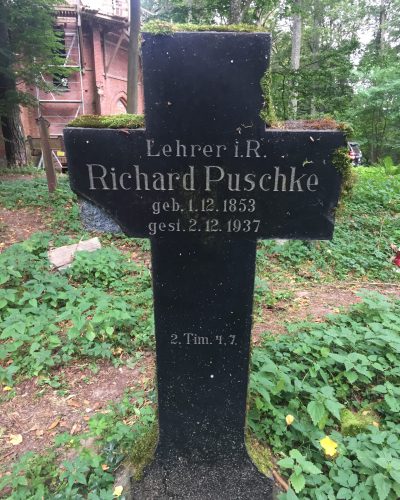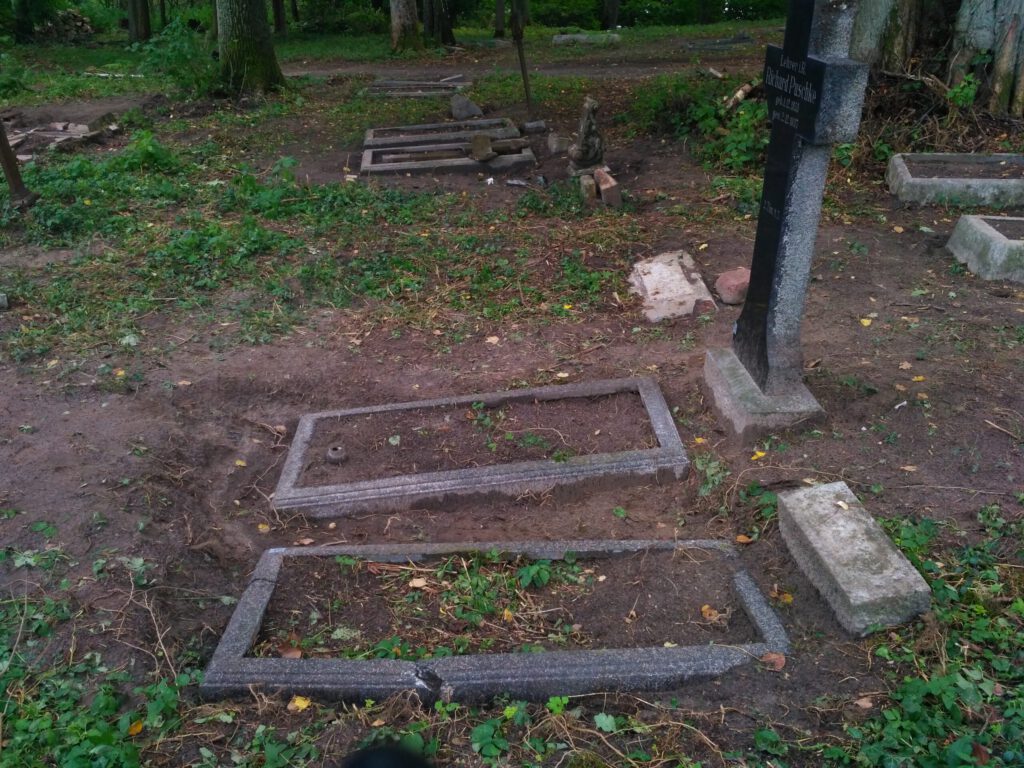Richard Franz Puschke was the youngest son of the Steinort teacher Friedrich Puschke and his wife Louise, both of whom were also buried in the same cemetery. At the death of his father in 1874, Richard succeeded him, just twenty years old, as a village teacher in Groß Steinort. He remained in this position until his retirement in 1920.[1]
Richard Puschke seems to have been a multifaceted man. The reference to Psalm Timothy 4:7 on his grave cross indicates this with retrospective satisfaction. The psalm reads: “I have fought the good fight, I have completed the course, I have kept the fifth.” His commitment took several forms.
Like most teachers of his time, Richard Puschke was a nationally minded person. He proved this during the 25th anniversary of the accession to the throne by Kaiser Wilhelm II in 1913, when he gave a patriotic address “for the appreciation of the day” to the assembled students from Groß Steinort, Rosengarten, Taberlack and Stawisken after a visit to the cemetery and Lehndorff mausoleum.
Above all, on this occasion, as in other occasions, he indulged in another passion, namely his enthusiasm for local history. He first showed the students the remains of a house that had sunk into the Steinort lake during the 16th century, supposedly the first house of the village. He then led them to the tomb of the Lehndorffs; then through the castle park of Steinort, where he interrupted the tour again and again with explanations on sandstone figures, clay vases, inscriptions and the sundial produced in 1765; and in the end he showed the students historical furniture and tapestries in the castle itself.[2]
In 1919, Richard Puschke apparently searched for old documents in archives for Count Carol Meinhard von Lehndorff in order to prove historical property rights.[3] With the Count, if one may believe an anecdote, he had a “real, cordial friendship”. This is said to have gained a special quality after a school visit, which the count carried out one day in the Steinort school. During this lesson, a pupil’s reckless statement revealed that the teacher kept a bottle of potato brandy in his desk. The Count was not bothered by this, on the contrary – he himself was all too inclined to a good drop. In any case, the visitation is said to have marked the beginning of a particularly close relationship between the count and the school teacher.[4]
However, this anecdote may also refer to Richard’s son Richard Alexander, who after him took over the school of Groß Steinort. In 1879 Richard had married Therese Marie David, the 19-year-old daughter of the Lehndorff castle gardener Samuel David and his wife Charlotte.[5] Richard’s parents-in-law are also buried in the cemetery of Groß Steinort. Therese and Richard had five children together.
The elder of Richard Puschke’s two sons, Richard Alexander, who was named after his father in 1883, became a teacher like him and grandfather Friedrich. He passed his exams in Angerburg and Osterode in 1903 and 1906, took part in the First World War and finally took over the school in Groß Steinort in 1921 in succession to his father and now at least the third generation. There he enjoyed a “good official residence” with four heated rooms. He died in 1935.[11]
At least one other Puschke completed the teacher dynasty: Heinrich Richard Puschke, as rector from 1905 to 1938 head of the village school in Rosengarten, which was equipped with three teacher positions, where he also played the organ in the church directly opposite the school. Born in 1876, he was probably a nephew of Richard Franz and cousin of Richard Alexander. He married Gertrude née Szimmat and had three children with her, one of whom died as a toddler. He too lived in a “good” official residence with four heated rooms until his retirement, when he built a large house with a garden and stables in Rosengarten. He died at the end of 1944. His wife and children Eva and Hans Albert moved to Hamburg. There, at least Hans Albert Puschke was lucky enough to escape the social decline that is often common for displaced persons. He gained a foothold as a pastor in the Wandsbek district of Hamburg.[12]
[1] https://lebenswelten-lehndorff.bbaw.de/dokumente/detail_doc.xql?id=lehndorff_gz4_j3n_g3b (Anmerkung)
[2] https://lebenswelten-lehndorff.bbaw.de/dokumente/detail_doc.xql?id=lehndorff_gz4_j3n_g3b&datum=&searchTerms=Puschke
[3] Gaby Huch, Die Lehndorffs, Berlin 2020, S. 342.
[4] Klaus Klootboom-Klootweitschen, Der Carol, Reinbek 1978, S. 48f. Most of the names in the book are encrypted: instead of Steinort, there is talk of Eichenort, the Lehndorffs are called Sassenburg, and the Puschkes Paschke.
[6] https://ofb.genealogy.net/famreport.php?ofb=rosengarten&ID=2-I62922&lang=de
https://ofb.genealogy.net/famreport.php?ofb=rosengarten&ID=2-I57516&nachname=Noetzel&lang=de
[7] https://ofb.genealogy.net/famreport.php?ofb=rosengarten&ID=2-I63204&lang=de
https://ofb.genealogy.net/famreport.php?ofb=rosengarten&ID=2-I41464&nachname=Kreutz&lang=de
https://ofb.genealogy.net/famreport.php?ofb=rosengarten&ID=2-I41475&lang=de
[8] Bundesarchiv Lastenausgleichsarchiv Bayreuth, OstDok 3/31, Bl. 86, 120, 124 (after that Paul Kreuz was allegedly “slain by Poles because he was hunting and possessed weapons”).
[9] https://ofb.genealogy.net/famreport.php?ofb=rosengarten&ID=2-I62755&lang=de
https://ofb.genealogy.net/famreport.php?ofb=rosengarten&ID=2-I62748&lang=de
[11] https://archivdatenbank.bbf.dipf.de/actaproweb/image.xhtml?id=2fd8e5a9-b06e-45d8-9722-f82f45dc884d
https://ofb.genealogy.net/namelist.php?nachname=SZIMMAT&ofb=rosengarten&modus=&lang=de
https://ofb.genealogy.net/famreport.php?ofb=rosengarten&ID=2-I63250&lang=de
Des Lehrers Auskunftsbuch: Statistisches Nachschlagewerk über die öffentlichen evangelischen und katholischen Volksschulen der Ostmark, Bearb. J. Bleise, 1925, S. 15. Bei Klootboom-Klootweitschen, Der Carol, Reinbek 1978, S. 48 states that even four generations of Puschkes were teachers in Groß Steinort one by one. Klara Karasch said after 1945 that the Puschkes had put the teachers there “for several generations”. (https://lebenswelten-lehndorff.bbaw.de/dokumente/detail_doc.xql?id=lehndorff_nwv_3cn_g3b&datum=&searchTerms=puschke ).
[12] Bundesarchiv Lastenausgleichsarchiv Bayreuth, ZLA/1/12323410; Des Lehrers Auskunftsbuch: Statistisches Nachschlagewerk über die öffentlichen evangelischen und katholischen Volksschulen der Ostmark, Bearb. J. Bleise, 1925, S. 15; https://archivdatenbank.bbf.dipf.de/actaproweb/image.xhtml?id=ffae646e-31f5-49bc-b527-d6826b4b72b7 https://ofb.genealogy.net/famreport.php?ofb=rosengarten&ID=2-I63243&lang=de
https://lebenswelten-lehndorff.bbaw.de/dokumente/detail_doc.xql?id=lehndorff_gz4_j3n_g3b&datum=&searchTerms=Puschke (Anmerkung).

